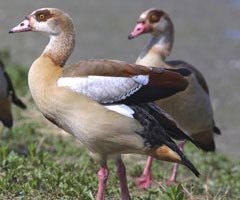 |

|
Currently there are no events or updates to display. |

The Unique Egyptian Goose Ever since I became interested in exhibition waterfowl in the 1960s, the Egyptian goose has fascinated me. Easily the smallest of the Standardized geese, these natives of Africa exhibit traits that make them unique. They are not a true goose, being classified by ornithologists as a member of the Shelduck family. In many ways, they look and behave as the other geese do. For example, Egyptians breed almost exclusively in pairs and the gander is very protective of the nest and of the youngsters. When they breed, females usually lay every day rather than every other day as the geese do. Their eggs also take somewhat longer to complete the incubation process, taking about 30 days as I recall. Egyptians make excellent parents and will fiercely defend their young against not only predators but their keepers as well. Their reputation is that they are ferocious but that is true only during the breeding season when each pair should be penned separately. At other times of the year, they are generally good citizens and get along fine with other waterfowl. During the breeding season they can be quite noisy, especially the females, who can be heard some distance off. The males have a distinct and much quieter call.
Assuming that one has the ability to keep pairs separate during the breeding season and that noise is not a big concern, the Egyptian is a fine bird to add to any collection of waterfowl. Be aware that Egyptians are capable flyers and as such, they should be pinioned or kept in covered runs. Note: In the state of Oregon, possession of Egyptian Geese is prohibited to anyone except an accredited zoo due to concerns that a feral population might be established. Originally published: 01-23-2006 |
Copyright © 1997 - 2026 Acorn Hollow Bantams. All Rights Reserved. | Terms of Use | Privacy Policy

 When well colored, the Egyptian is a striking bird. Distinct eye patches mark the head. The red over the back contrasts with the rich reddish brown of the breast and lower body. The breast is marked with a blaze or disk that is dark brown in color and large in size. The wing bows are a clear white in adults. In young birds, the wing bows usually contain some gray smut. The bad news is that really well colored and marked Egyptians are fairly rare at the shows, most birds showing gray and brown where the red should be, washed out color in the lower body, and small, indistinct blazes.
When well colored, the Egyptian is a striking bird. Distinct eye patches mark the head. The red over the back contrasts with the rich reddish brown of the breast and lower body. The breast is marked with a blaze or disk that is dark brown in color and large in size. The wing bows are a clear white in adults. In young birds, the wing bows usually contain some gray smut. The bad news is that really well colored and marked Egyptians are fairly rare at the shows, most birds showing gray and brown where the red should be, washed out color in the lower body, and small, indistinct blazes.